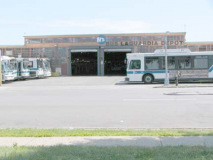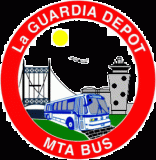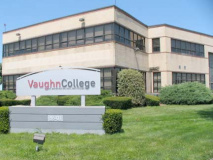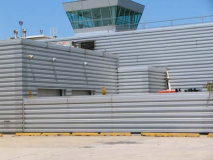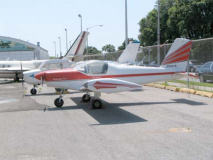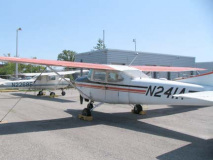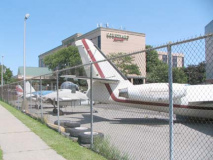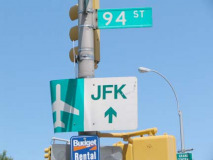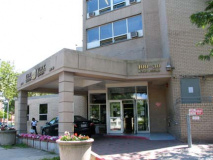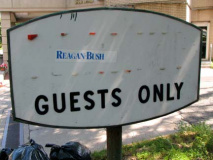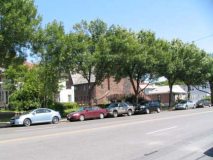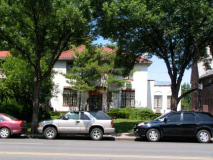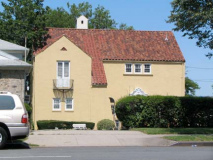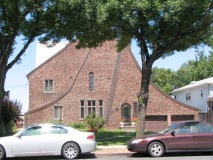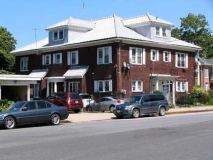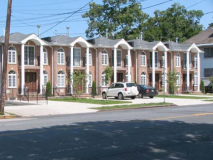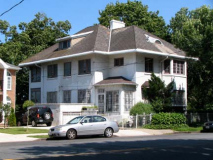

Ditmars Boulevard is interrupted for a couple of blocks between 82nd and 86th Streets, partly a consequence of the construction of LaGuardia, né Glenn Curtiss Airport, in the early 1930s. 23rd Avenue (left) skirts the southern boundary of the airport for a couple of blocks and is lit by dwarf lampposts designed to not interfere with landing strip lights. I’ve always been curious about the grassy area south of 23rd between 82nd and 83rd Streets — it is barren of trees and has several lamp stanchions. Probably there to guide aircraft, but how, exactly?
This, as well as other areas southwest of here is indeed an approach for Runway 4, the main SW-NE runway at LGA.
Glenn Curtiss (1878-1930) was an early aeronautical pioneer in the period immediately following the Wright Brothers’ famed breakthrough at Kitty Hawk, NC. He flew the June Bug to nearly a mile high on July 4, 1908 and the following year participated in the first sanctioned airplane race, the Grande Semaine d’Aviation, at Rheims, France and emerged the victor. During the pre-World War I period he continued to innovate heavier-than-air seaplanes that could take off and land on water, beginning a lengthy association with the U.S. Navy. The Curtiss-Wright Corporation, a descendant of the Curtiss Aeroplane and Motor Company, continues as a major player in the aerospace field.

LaGuardia Airport was constructed in 1929 as Glenn Curtiss Field, and later, North Beach Airport, replacing a former North Beach amusement area called the Gala Amusement Park, opened in 1889 by piano master William Steinway and beer baron George Ehret; it fell flat when Prohibition was enacted in 1920. The North Beach area and park were served by the Brooklyn City Railroad, which operated a trolley line along Old Bowery Bay Road, once one of the only thoroughfares in eastern Jackson Heights and East Elmhurst. The line survived into the 1930s and served the airport for a time.
North Beach Airport was expanded for full commercial traffic in 1937 after Mayor Fiorello LaGuardia took a commercial flight to NYC only to land at Newark Airport. Indignant, he demanded to be taken to NYC on board the aircraft, which took off once again and landed at Floyd Bennett Field on Jamaica Bay, the only airfield with runways long enough to accommodate a commercial flight in those days. The new airport needed to be built on landfill supported on a metal frame that still interferes a little with the compasses on board planes that are taking off; pilots have to compensate for it. North Beach Airport was expanded from 550 acres to over 800 and was opened October 15, 1939 as The NY Municipal Airport. At the time, Time Magazine called it “the most pretentious land and seaplane base in the world.” (In 1939, pretentious was a compliment.) The country’s five major airlines in 1939, Pan American Airways, American, United, Eastern Air Lines and Transcontinental & Western Air (TWA) were original tenants.
There have been only 4 plane crashes on takeoff or landing from LaGuardia over the years. On January 15, 2009, US Airways Flight 1549 to Charlotte, NC suffered total engine failure after being struck by a flock of geese at 3000 feet. Captain Chesley Sullenberger and crew safely managed a water landing in the Hudson River with no casualties and only minor injuries.
Above: runway seen from 86th Street and Ditmars Boulevard
Ditmars Boulevard restarts again, quietly, at 86th Street just off 23rd Avenue. There is also a depot here for more mundane, earthbound means of transport: The MTA LaGuardia Bus Depot.
The depot logo features the Triborough (RFK) Bridge, the LaGuadia Airport control tower (due to be replaced soon; see below) and an airplane taking off what appears to be the American Airlines terminal (see below).
LGA Depot handles the Q18, Q19, Q23, Q29, Q33, Q38, Q39, Q45, Q47, Q49, Q53, Q69, Q72 and express QM10, QM11, QM12, QM22, QM24, QM24W routes, all part of the Triboro Coach lines that were taken over by the MTA February 20, 2006; Triboro Coach had operated since April 1931.
One aspect of Triboro Coach has remained unchanged since the MTA takeover: its lines’ bus stops remain unmarked by bus routes and schedules, unlike pre-existing MTA bus lines!
Vaughn College of Aeronautics and Technology, 23rd Avenue and 86th Street, began in 1932 [in Newark, NJ] when Charles S. “Casey” Jones, a pioneer aviator and aviation company executive, foresaw the need for highly trained technicians to design, build and service aircraft and engines. George A. Vaughn, Jr. and Lee D. Warrender joined with Casey Jones in founding the Casey Jones School of Aeronautics, the predecessor of the Academy of Aeronautics, and as of September 1986, the College of Aeronautics. vaughn.edu
Along Ditmars Boulevard, a number of vintage vehicles are displayed. Name That Plane!
The Courtyard Marriott is one of many hostelries to be found along the airport’s southern rim.
94th Street is the main entrance valve for LaGuardia, which is constructing a new control tower that will replace the current one constructed in 1962.
LGA vs JFK: you’d be surprised how many people go to the wrong airport. The Department of Transportation helpfully has a sign directing motorists to the Van Wyck Expressway, where JFK Airport is located at its southern end.
This is one of the first green streetsigns installed in the 1980s. How do you tell? It’s quite simple. The oldest ones have no white stripes at the top and bottom.

Ditmars Avenue/Boulevard, in an area map from about 1915-1920. As we can see, the region is built over the now filled-in Jackson Mill Pond. In the 1800s, there was indeed a mill here, known as Kip’s and then Jackson’s Mill, used to grind wheat and corn for area residents until 1870. The mill may have been renamed to honor John Jackson, who built an east-west toll road through what was known in the 1800s as Trains Meadow. That road, of course, is the present Northern Boulevard.
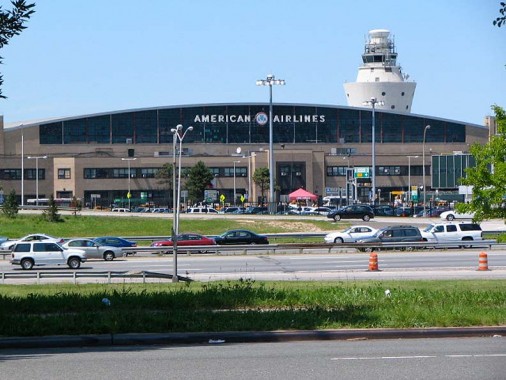
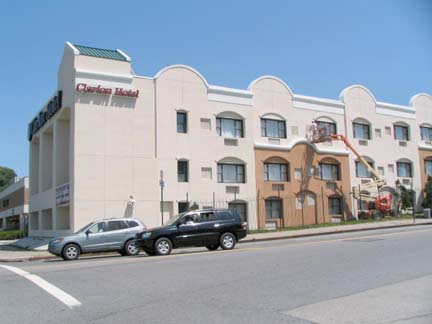
The classic American Airlines terminal, which may date back to LGA’s earliest days. In the foreground is Grand Central Parkway and the 1962 control tower is seen in the background. (All are there due to the direct or partial influence of the much-reviled Robert Moses, but the transit czar had his moments). 1939 was likely the last gasp of practical architecture with soul; compare the pedestrian Clarion Hotel on Ditmars and 94th.
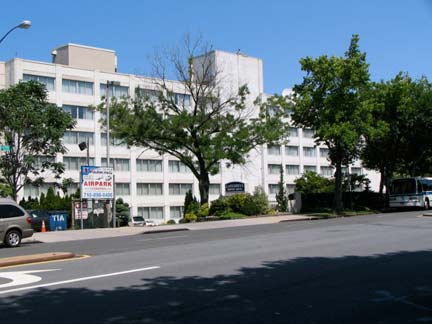
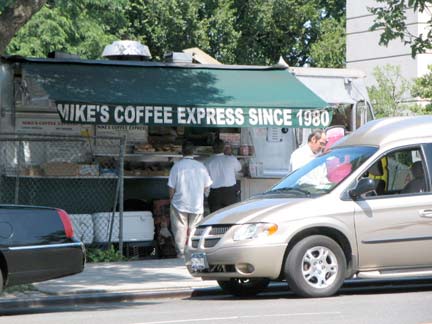
The LaGuardia Airport Hotel is the most venerable hotels along what has become a hotel row as Ditmars Boulevard turns southeast at about 100th Street. Mike’s Coffee Express, as the sign says, has served customers here for nearly 30 years.
Mike has no idea what youtube is, and why should he?
Ditmars Boulevard intersects 23rd Avenue again at 102nd Street at Elm York Assisted Living. Do they only take Republicans?
Hotel Row
Ditmars Boulevard’s Hotel Row runs from 100th Street southeast to almost 25th Avenue; there are several hostelries here, one bigger than the other, from the older, pedestrian LaGuardia Airport Hotel to the big red Crowne Plaza…
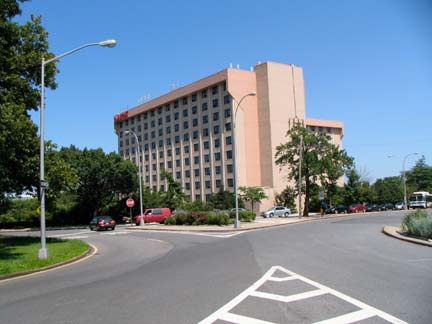
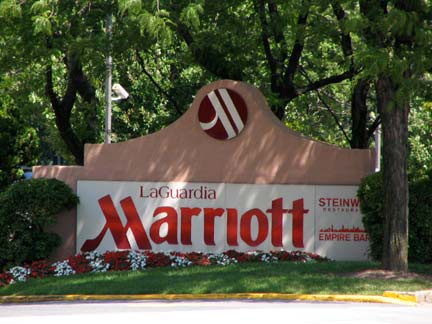
Some have been opened in recent years such as the LaGuardia Marriott, the second Marriott on Ditmars (cf. Courtyard Marriott on 90th Street, shown above.)
The construction of this Hampton Inn requires the moving or destruction of a rather large rock outcropping. These are relatively rare in Queens (though I’ve seen more of them in East Elmhurst outings several years ago). The most common place to see them is in northern Manhattan and the Bronx.
ForgottenFan Eric Weaver: You are wrong to call the big rock an outcropping. Long Island is a pile of rocks scraped of of New England. It is called an erratic as it isn’t attached to the layers below like the ones on your link to outcroppings. It is a glacial term as all of Long Island is glacial unlike the Bronx and Manhattan which have bedrock.
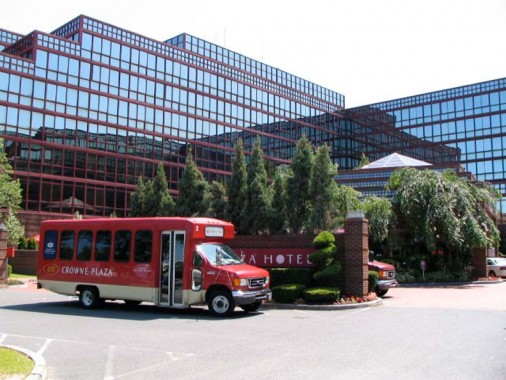
InterContinental Hotels has operated Crowne Plaza Hotels since 1983. The one on Ditmars Boulevard appears to have drowned in a huge bucket of red paint, though I like the hundreds (thousands?) of windows.
East Elmhurst
Ditmars Boulevard runs along the northeast boundary of East Elmhurst, which some say encompasses everything north of Northern Boulevard and east of the Brooklyn Queens Expressway; I think a good chunk of that is Jackson Heights and I restrict EE to everything east of Junction Boulevard/94th Street and north of Northern. The name makes little sense to me because even at its broadest limit, it’s east of Astoria and at best, north-northeast of Elmhurst with Jackson Heights in between.
The part of East Elmhurst that Ditmars Blvd. passes through developed relatively early on, in 1905, even before the opening of the Queensborough Bridge. During its relatively lengthy history East Elmhurst became home to a number of famed musicians (joining Addisleigh Park in south Jamaica in this regard) including Ella Fitzgerald and Harry Belafonte (and nearby Corona boasted the longtime homes of Louis Armstong and Dizzy Gillespie). Malcolm X was also a resident, but his stint in East Elmhurst is marred by an ugly incident in which his family’s house on 97th Street was firebombed February 14, 1965, just one week before he was fatally shot in Harlem. 97th Street is marked by a street sign bearing his name.
Along Ditmars Boulevard, there’s a group of homes overlooking Flushing Bay that date from the very early 20th Century with eclectic architectural design — I have yet to see them mentioned in any proposed Landmarks Preservation Commission report, and so they’re always subject to the predations of overdevelopers who, as we’ll see, have already made some incursions.
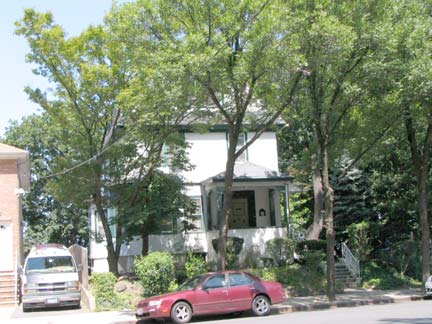

Walking southeast on Ditmars the first such home you’ll see is opposite 25th Avenue. Surrounded by foliage, it’s a welcome change of pace from he monster hotels you have previously passed by here. 25th Avenue is a step street between Butler Street and Ditmars Boulevard, but you won’t see that shown on any commercial map I have seen.
OK, botanists, Name That Tree. A line of identically-pruned trees line the north side of Ditmars Boulevard. What are they? And what’s behind the trees? Some of the most beautiful buildings in north central Queens, including several with Spanish stylings. All these homes have views of Flushing Bay.
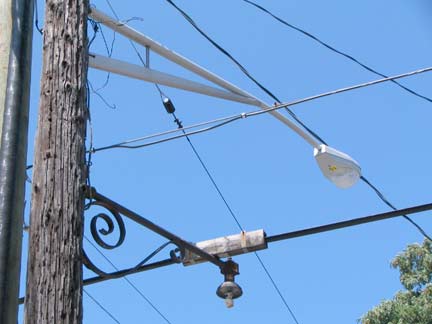
Phased-out fire alarm lamp, Ditmars Blvd. and 27th Avenue. In the 1990s, a great number of public fire alarms were decommissioned due to excessive false alarms being called in. Some of the boxes have remained active, but in the early 2000s, the small lamps signifying the boxes were changed from oblong orange lamps to small red cyliders mounted near the top of the post, or on the streetlamp luminaire.
This one is an example of a scrolled fire alarm lamp stanchion that was adapted from an earlier stanchion that held the streetlamp.
Near 29th Avenue on the Flushing Bay side, a pair of large houses (possibly multifamily) flank some new construction. These aren’t all that bad, but they’re not up to the standard of the rest of the Flushing Bay side houses.
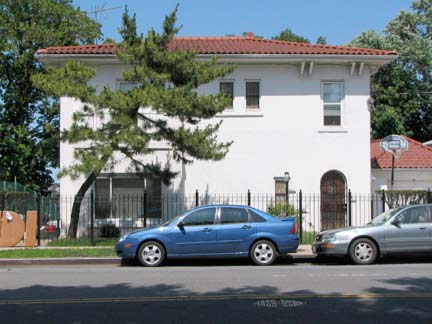
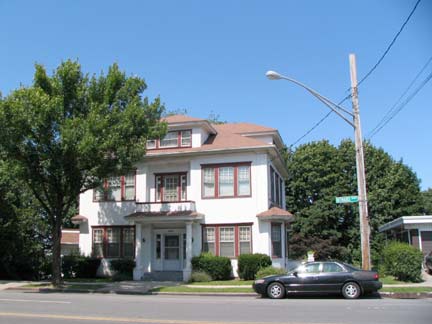
Another pair of Flushing Bay facing houses.
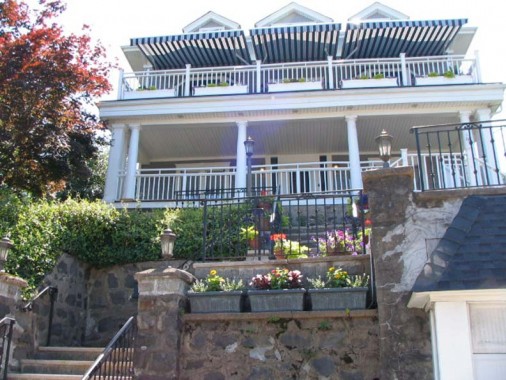
This Doric-columned building at 31st Avenue has two porches on two floors, the better to view the bay from the west side of Ditmars Boulevard.
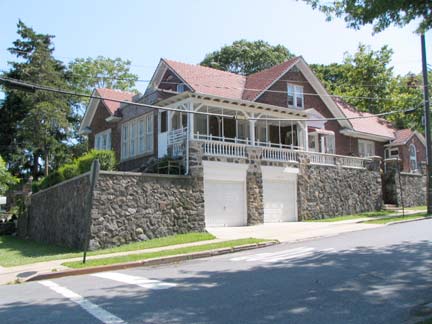
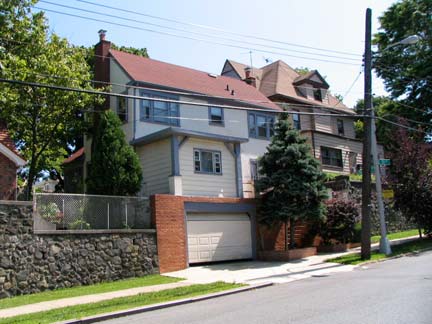
Arts and Crafts-y houses at Ditmars Boulevard and 31st Avenue that combine high stone walls and stick-style Victorian-era construction.
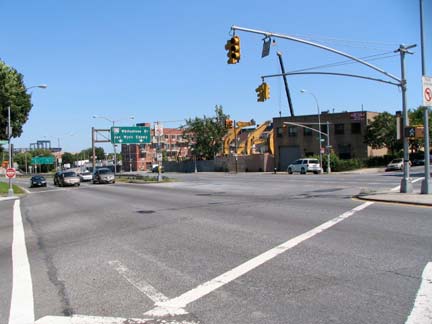
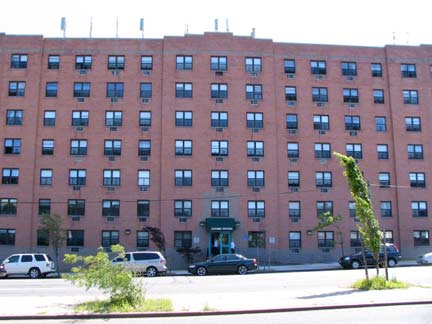
At Ditmars Boulevard’s end at Astoria Boulevard close to its intersection with Grand Central Parkway, reality hits hard and we’re greeted with decidedly more mundane fare. From Astoria Park to Astoria Boulevard, life on Ditmars comes to an end here.
7/26/2009


